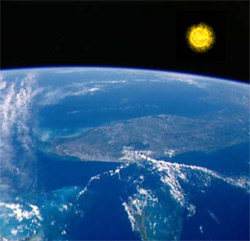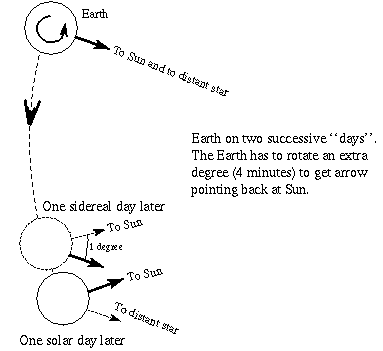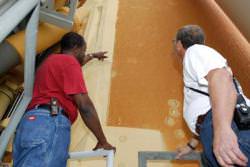I don’t usually repost blog entries, but it’s the end of the year, and my post at this time last year took me forever to research and write, and I like it so much I’m gonna just plop it down here to end 2007. Enjoy.

Yay! Tonight at midnight it’s New Year!
But what does that mean, exactly?
The year, of course, is the time it takes for the Earth to orbit the Sun, right? Well, not exactly. It depends on what you mean by "year", and how you measure it. This takes a wee bit of explaining, so put down the champagne, take the lampshade off your head, and hang on.
First, I will ignore a few things. For example, time zones. These were invented by a sadistic watchmaker, who only wanted to keep people in thrall of his devious plans. So for now, let’s just ignore them, and assume that for these purposes you spend a whole year (whatever length of time that turns out to be) planted in one spot (though I’ll note that as I write this, it’s already 2007 in Australia and other points west of the international date line).
However, I will not ignore the rotation of the Earth. That turns (haha) out to be important.

Let’s take a look at the Earth from a distance. From our imaginary point in space, we look down and see the Earth and the Sun. The Earth is moving, orbiting the Sun. Of course it is, you think to yourself. But how do you measure that? For something to be moving, it has to be moving relative to something else. What can we use as a yardstick against which to measure the Earth’s motion?
Well, we might notice as we float in space that we are surrounded by zillions of pretty stars. We can use them! So we mark the position of the Earth and Sun using the stars as benchmarks, and then watch and wait. Some time later, the Earth has moved in a big circle and is back to where it started in reference to those stars. That’s called a "sidereal year" (sidus is the Latin word for star). How long did that take?
Let’s say we used a stopwatch to measure the elapsed time. We’ll see that it took the Earth 31,558,149 seconds (some people like to approximate that as pi x 10 million (31,415,926) seconds, which is an easy way to be pretty close). But how many days is that?
Well, that’s a second complication. A "day" is how long it takes the Earth to rotate once, but we’re back to that measurement problem again. But hey, we used the stars once, let’s do it again! You stand on the Earth, and define a day as the time it takes for a star to go from directly overhead to directly overhead again: a sidereal day. That takes 23 hours 56 minutes 4 seconds = 86,164 seconds. But wait a second (a sidereal second?) — why isn’t that exactly equal to 24 hours?
I was afraid you’d ask that — but this turns out to be important.
It’s because the 24 hour day is based on the motion of the Sun in the sky, and not the stars. During the course of that almost-but-not-quite 24 hours, the Earth was busily orbiting the Sun, so it moved a little bit of the way around its orbit (about a degree). If you measure the time it takes the Sun to go around the sky once — a solar day — that takes 24 hours, or 86,400 seconds. It’s longer than a sidereal day because the Earth has moved a bit around the Sun during that day, and it takes a few extra minutes for the Earth to spin a little bit more to "catch up" to the Sun’s position in the sky.
Here is a diagram from Nick Strobel’s fine site Astronomy Notes that will help explain this:

See how the Earth has to spin a little bit longer to get the Sun in the same part of the sky? That extra 4 minutes (really 3 m 56 s) is the difference between a solar and sidereal day.
OK, so we have a year of 31,558,149 seconds. If we divide that by 86,164 seconds/day we get 366.256 days per year.
Wait, that doesn’t sound right. You’ve always read it’s 365.25 days per year, right? But that first number, 366.256, is a year in sidereal days. In solar days, you divide the seconds in a year by 86,400 to get 365.256 days.
Phew! That number sounds right. But really, both numbers are right. It just depends on what unit you use. It’s like saying something is 1 inch long, and it’s also 2.54 centimeters long. Both are correct.
Having said all that, I have to admit that the 365.25 number this is not really correct. It’s a cheat. That’s really using a mean or average solar day. The Sun is not a point source, it’s a disk, so you have to measure a solar day using the center of the Sun, correcting for the differences in Earth’s motion as it orbits the Sun (because it’s not really a circle, it’s an ellipse) and and and. In the end, the solar day is really just an average version of the day, because the actual length of the day changes every, um, day.
Confused yet? Yeah, me too. It’s hard to keep all this straight. But back to the year: that year we measured was a sidereal year. It turns out that’s not the only way to measure a year.
You could, for example, measure it from the exact moment of the vernal equinox in one year to the next. That’s called a tropical year. But why the heck would you want to use that? Ah, because of an interesting problem! Here’s a hint:

The Earth precesses! That means as it spins, it wobbles very slightly, like a top does as it slows down. The Earth’s wobble means the direction the Earth’s axis points in the sky changes over time. It makes a big circle, taking over 20,000 years to complete one wobble. Right now, the Earth’s axis points pretty close to the star Polaris, but in a few hundred years it’ll be noticeably off from Polaris.
Remember too, that our seasons depend on the Earth’s tilt. Because of this slow wobble, the tropical year (from season to season) does not precisely match the sidereal year (using stars). The tropical year is a wee bit shorter, 21 minutes or so. If we don’t account for this, then every year the seasons come 21 minutes earlier. Eventually we’ll have winter in August, and summer in December! That’s fine if you’re in Australia, but in the northern hemisphere this would cause, panic, rioting, bloggers blaming each other, etc.
So how do you account for it? Easy: you adopt the tropical year as your standard year. Done! You have to pick some way to measure a year, so why not the one that keeps the seasons more or less where they are now? This means that the apparent times of the rising and setting of stars changes over time, but really, astronomers are the only ones who care about that, and they’re a smart bunch. They know how to compensate.
Okay, so where were we? Oh yeah– our standard year (also called a Gregorian year) is the tropical year, and it’s made up of 365.24 mean solar days, each of which is 86,400 seconds long, pretty much just as you’ve always been taught. And this way, the vernal equinox always happens on or around March 21 every year.
But there are other "years", too. The Earth orbits the Sun in an ellipse, remember. When it’s closest to the Sun we call that perihelion. If you measure the year from perihelion to perihelion (an anomalistic year) you get yet a different number! That’s because the orientation of the Earth’s orbital ellipse changes due to the tugs of gravity from the other planets. It takes about 100,000 years for the ellipse to rotate once relative to the stars! Also, it’s not a smooth effect, since the positions of the planets change, sometimes tugging on us harder, sometimes not as hard. The average length of the anomalistic year is 346.6 solar days, or 29,947,974 seconds 365.26 days, or 31,558,432 seconds. What is that in sidereal days, you may ask? The answer is: I don’t really care. Do the math yourself.
Let’s see, what else? Well, there’s a pile of years based on the Moon, too, and the Sun’s position relative to it. There are ideal years, using pure math with simplified inputs (like a massless planet with no other planets in the solar system prodding it). There’s also the Julian year, which is a defined year of 365.25 days (those would be the 86,400 seconds-long solar days). Astronomers actually use this because it makes it easier to calculate the times between two events separated by many years. I used them in my PhD research because I was watching an object fade away over several years, and it made life a lot easier.
So there you go. As usual, astronomers have taken a simple concept like "years" and turned it into a horrifying nightmare of nerdy details. But really, it’s not like we made all this stuff up. The fault literally lies in the stars, and not ourselves.
Now if you’re still curious about all this even after reading my lengthy oratory, and you want to know more about some of these less well-known years, then check out Wikipedia. They have lots of info, but curiously I found it rather incomplete. I may submit something to them as an update (like how many seconds are in each kind of year; they only list how many days, which is useful but could be better).
I have to add one more bit of geekiness. While researching this entry, I learned a new word! It’s nychthemeron, which is the complete cycle of day and night. You and I, in general, would call this a "day". Personally, if someone dropped that word into casual conversation, I’d beat them with my orrery and astrolabe.
Incidentally, after all this talk of durations and lengths, you might be curious to know just when the Earth reaches perihelion, or when the exact moment of the vernal equinox occurs. If you do, check out the U.S. Naval Observatory website. They have tons of gory details about this stuff.
Hmmmm, anything else? (counting on fingers) Years, days, seconds, yeah, got those. Nychthemeron, yeah, Gregorian, tropical, anomalistic… oh wait! I know something I forgot to say!
Happy New Year.








